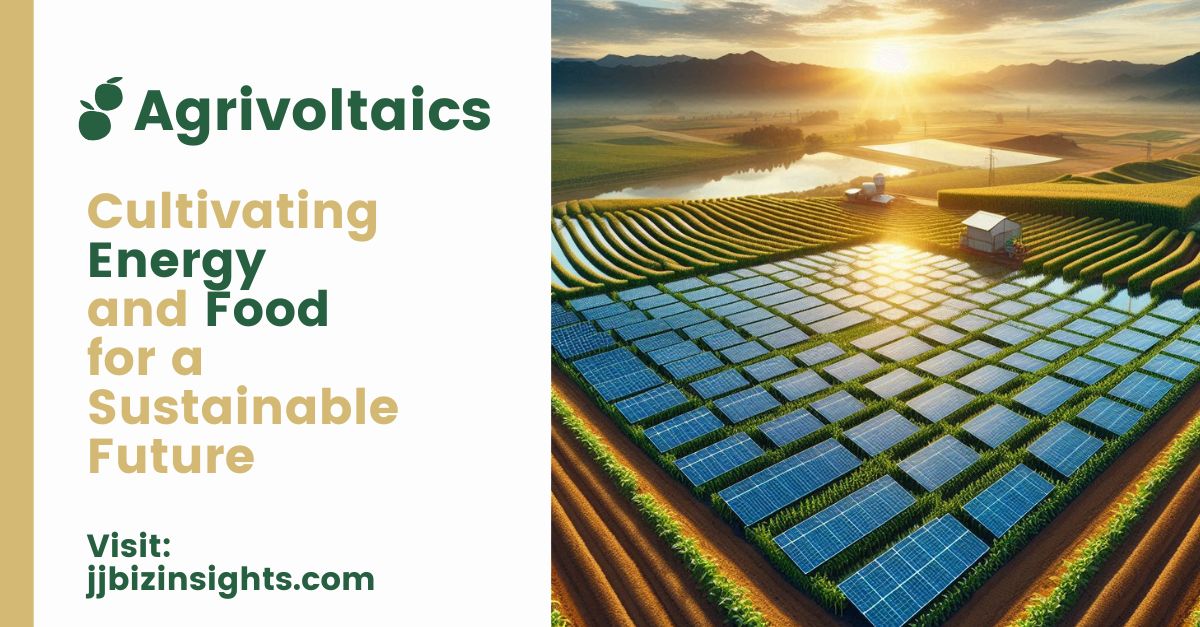
Agrivoltaics: Cultivating Energy and Food for a Sustainable Future
Agrivoltaics, the practice of installing solar panels on the same land as agricultural crops or grazing, is revolutionizing the way we think about farming and energy production. This innovative approach offers a harmonious blend of agriculture and renewable energy, promising significant environmental and economic benefits.
The Dual Benefits of Agrivoltaics
Agrivoltaics provides two main benefits:
- Protection and Efficiency: Solar panels offer partial shade to crops, protecting them from excessive heat and conserving soil moisture. The shade reduces the stress on plants, leading to healthier growth. Additionally, crops release water vapor, which helps cool the solar panels, improving their efficiency.
- Enhanced Crop Yields and Reduced Water Usage: Studies have shown that agrivoltaics can increase crop yields by 20% to 60% while reducing water consumption by approximately 20%. This dual advantage is particularly beneficial in regions facing water scarcity and high temperatures.
It has proven most successful with short crops like herbs, vegetables, and fruits such as strawberries. The synergy between solar panels and these crops creates a microenvironment that fosters growth and sustainability.
Agrivoltaics in the United States
The United States Department of Energy predicts that solar energy projects will occupy over 10 million acres of land by 2050, with 90% of that land located in rural areas. This vast potential highlights the importance of integrating agrivoltaics into agricultural practices.
Currently, there are more than 567 agrivoltaic sites in the United States, producing 10 gigawatts (GW) of power. These sites exemplify the successful marriage of energy production and agriculture, demonstrating the feasibility and benefits of agrivoltaics.
Agrivoltaics Around the World
It is gaining traction globally, with various countries adopting this innovative approach to integrate solar energy and agriculture.
Germany
Germany is at the forefront of agrivoltaic research and development. The Fraunhofer Institute for Solar Energy Systems ISE is actively working on projects such as PV greenhouses for shrimp production in Vietnam, tracked agrivoltaics for apple farming, and integrated rainwater harvesting systems in semi-arid regions of Western Africa. These projects aim to optimize the integration of photovoltaic (PV) systems to serve agricultural production.
Vietnam
In Vietnam, agrivoltaic systems are being used to create PV greenhouses for shrimp farming. This approach not only provides shade and reduces water evaporation but also generates renewable energy.
Western Africa
Western Africa is exploring integrated rainwater harvesting and water management systems for agrivoltaic setups. These systems are designed to improve water efficiency and support crop growth in arid climates.
United Kingdom
The United Kingdom has seen a significant adoption of agrivoltaics, with around 30% of British farmers either installing rooftop or ground-mounted solar panels. The National Farmers Union (NFU) encourages farmers to use solar PV for energy production while continuing agricultural activities such as grazing and creating wildlife habitats.
Australia
Australia is also embracing agrivoltaics, with several projects focusing on combining solar energy production with livestock farming. These projects aim to provide shelter for animals while generating renewable energy.
The global landscape of agrivoltaics is diverse, with each region tailoring the approach to its specific agricultural needs and climatic conditions. As the technology continues to evolve, agrivoltaics holds the promise of a sustainable future where energy and food production go hand in hand.
What’s Next for Agrivoltaics?
Agrivoltaics is part of the larger sustainable agriculture meta trend, driven by the urgent need to address climate change and food security. Here are some insights into the future of agrivoltaics:
- Mitigating Greenhouse Gas Emissions: Food production accounts for over one-quarter of global greenhouse gas emissions. Agrivoltaics can help reduce these emissions by promoting sustainable farming practices and reducing the carbon footprint of energy production.
- Adoption of Sustainable Farming Practices: A significant number of farmers are already aware of and adopting sustainable farming methods. Nearly 70% of farmers are practicing reduced- or no-till farming, and about 50% are modifying their fertilizer applications to be more environmentally friendly.
- Corporate Sustainability Initiatives: Food corporations are also embracing sustainable practices. For instance, Mars, the global candy maker, has implemented 27 sustainable agriculture projects across 10 countries, covering more than a million acres of farmland.
- Innovative Agricultural Technologies: Agtech companies like X Farm are developing technologies that help farmers optimize their practices. These technologies enable farmers to accurately assess their irrigation and fertilizer needs, reducing waste and enhancing crop productivity.
One noteworthy sustainable option is biochar fertilizer, made by burning food and plant waste without oxygen. Biochar improves soil health, aids plant nutrient uptake, and reduces the need for chemical fertilizers.
Conclusion
Agrivoltaics is a promising solution that addresses the dual challenges of sustainable food production and renewable energy generation. By integrating solar panels with agricultural practices, we can create a more resilient and efficient system that benefits both farmers and the environment. As we move forward, the adoption of agrivoltaics and other sustainable practices will be crucial in shaping a greener and more sustainable future.
Embrace the power of agrivoltaics and be part of the movement towards a sustainable and energy-efficient world. 🌱☀️
Transformative Technologies Shaping Our Future: A Dive into the Cutting Edge




